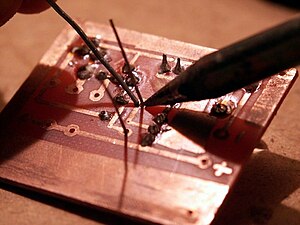Soldering
Soldering in electronics is used to connect components to the PCB circuit board and sometimes wires to components.
Preparation
Do not use lead free solder. Use good quality 60/40 solder (60% tin and 40% lead). This has a melting point of around 190°C, depending on the exact composition. A soldering iron tip temperatures of at least 300°C (a soldering iron rated at 35 to 50 Watt) is recommended. With 60/40 cracks don't form so readily if the joint moves during cooling. Don't use too much solder. Don't try to solder oxidised copper, rub it down first. Larger wires or areas of copper will be more difficult to solder. When redoing work use the same type of solder to that already used on the product, e.g. if repairing lead free solder work use lead free solder.
Method
First tin the soldering iron tip. Clean the tip of the iron with a damp sponge or brass wool.
Use solder wick to remove any excess solder or to undo solder joints. Melting a touch of fresh solder first, makes the solder already in place melt easier.
Through hole
Touch the soldering iron to the connection for about half a second before touching it with the solder, wait until the solder flows easily. Hold the iron there for another half second before taking it away. While doing this blow the solder flux fumes away.
SMT hand soldering
...
SMT reflow soldering
...
Cleaning flux
Flux leaves a brown residue that attracts moisture and can cause problems in sensitive circuits. To clean 60/40 solder flux residue, use 99% isopropyl alcohol, this is close to the anhydrous isopropyl alcohol commonly used in industry to clean PCBs. Cover the spot of flux with a Kimwipe (or good quality paper towel), then soak the paper with alcohol and then poke and scrub at it with a small stiff brush, (an acid brush with the bristles cut down to 6 mm or so). Keep adding alcohol and moving the towel to a fresh spot until the paper comes clean.
Health and safety
The main concern with lead in solder isn't its use in soldering, but its environmental impact when the product is discarded.
At typical soldering temperatures, metal vapours aren't present in the air because the heat isn't enough to vaporize the solder. The smoke comes from the flux. While flux smoke is also harmful, it doesn't contain any metals. Use a fan to blow the smoke away anjd work in a well ventilated space.
As long as you don't eat where you solder and wash your hand before eating, then lead-based solder is completely safe to use.
See also
External links
Tutorials
- The basic soldering guide by Alan Winstanley
- How to Solder Correctly – and Why, CuriousInventor
YouTube
- EEVblog #180 – Soldering Tutorial Part 1 – Tools
- EEVblog #183 – Soldering Tutorial Part 2
- Basic Soldering Lessons 1 - 9, PACE, Inc
- Rework & Repair Lessons 1 - 8, PACE, Inc
⮜ Previous: Prototyping Next: Fault finding ⮞


